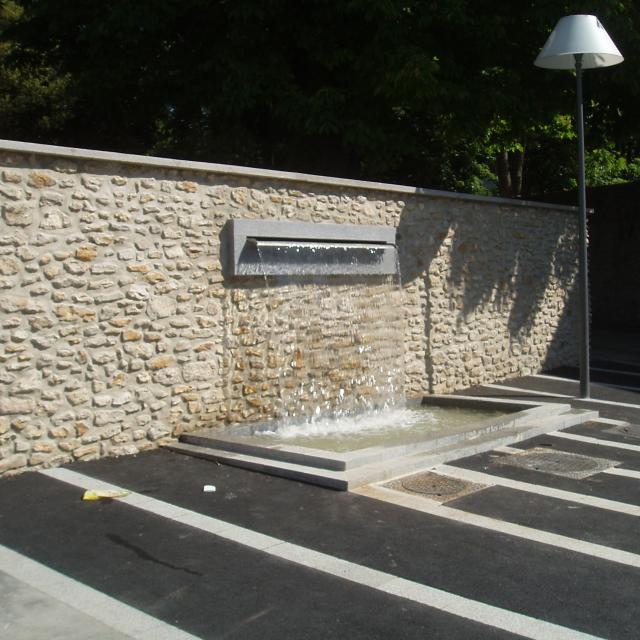Dominique Raveraud, president of the company G2E IDFA Ile-de-France Arrosage, has, for 15 years, been studying ways of promoting the sustainable management of water resources within an urban environment. His project has been adopted and applied in many towns in the Ile-de-France and the provinces, including the town of Orly.

The town’s Mayor, Mrs. Christine Janodet, whom I sincerely thank for the time she has given us, is well aware of the challenge facing her in supplying water for urban landscaping and she has expressed her desire to develop the green spaces and decorate the town with flowers, in an area that already consumes a lot of water, since the town of Orly has a large housing stock inherited from the 1960s and 1970s.
Its location on the catchment basin of the slopes of the Seine makes it a natural route for circulating the waters that originate from the plateau of Orly airport before being released into the Seine.
From these observations, she embarked upon a genuine water management policy for the town, with the aim of making it self-sufficient in the use of water (for irrigation and cleaning).
This approach cannot be made possible unless there is thorough consultation with the green space department, which must eventually have ZERO USE of insecticides and herbicides on soils and green spaces, thus preventing the water from being polluted.
she embarked upon a genuine water management policy for the town, with the aim of making it self-sufficient in the use of water (for irrigation and cleaning).
Attracted by Mr. Raveraud’s project, a hydraulic audit of the town was carried out in order to identify the different water sources (spring water, waste water, rainwater) and to define their uses and quantify the needs and resources, adapting each project to these precepts.
The town of Orly has considerable water resources, particularly spring water and surface runoff water, which are available in significant quantities and unexploited up to now.
It has, therefore, been decided to use this water for cleaning pavements (sidewalks), gutters and public places, irrigating the numerous plant-holders and small gardens located along the pavements and finally to create fountains.
The water used for cleaning the public places (pavements, main square and spaces, gutters) comes from the reserve stored in different parts of the city.
The water used for cleaning the market place comes from the systems used for collecting rain water from the neighbouring houses, this rainwater harvesting having been made possible at very little expense when the city centre was renovated. This stock of water is stored in a number of tanks totalling 100 m3. A water supply unit allows the water tanks to be filled for the watering of the hanging flowers.
Finally, a holding tank of 700 m3 will allow the water to be recovered from the swimming pool during its daily cleaning (60 m3) and the bi-annual emptying of the 600 m3 tank, which will then be used for cleaning the roads by installing a water supply unit and filling device, these areas currently being cleaned by water drawn from the town’s drinking water supply system.
This project will enable the town to be completely self-sufficient in water for cleaning roads and public places in early autumn 2012. Eventually, there will be three large storage tanks in Orly, with a total capacity of 1,600 m3.
Another area of use for the water: the fountains.
The fountain in the market place, built of grey stone in a refined style, is supplied by a natural spring, the water being withdrawn and then stored in a reservoir, which is used to operate a closed-circuit system, the spring supplying the booster pump that maintains the level of the storage tank.
There are currently plans for two other fountains: in the Place du 8 mai, where, on this occasion, the fountain will be supplied by recovered rain water; the removal of all pesticides and herbicides before its use in the closed circuit system, booster and automatic water level system being carried out via a retention basin of 800 m3, with an overflow system sending the water into a storage tank.
The idea is to restore the town’s « traditional water supply » for as many projects as possible.
The town has held discussions with the municipal public services and a landscape contractor on the subject of renovating the Georges Meliès park, which dates back to the XVIII and XIX century, this being a classic park with romantic gardens, rockeries, a lake and cascades … Nowadays, it operates artificially with the use of pumps, but in the long term, the aim is to have a supply of natural water and studies are being carried out on the possibility of treating the water with a form of phytoremediation.
Today, 29 sites are irrigated in Orly. The system, which is quite old, uses a lot of water. Work is currently being carried out on the streamlining of the installations. Water recovery, precise computerised water management systems, the use of components for measuring soil water tension, meteorological stations and the replacement of equipment that consume a lot of water are measures that are currently in process and this will become more widespread as the urban regeneration work progresses, within the context of the ANRU 2 programme.

